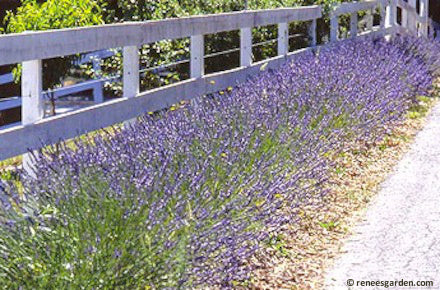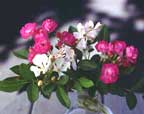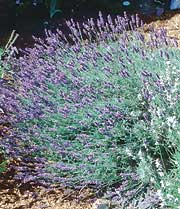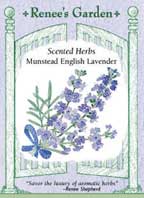
Lavender and Roses from Seed
Both lavender and roses have been cultivated for centuries as their timeless beauty has adopted to changing gardening fashions. In the formal gardens of the Romans, who bathed in lavender and rose-scented waters, in medieval apothecaries' gardens, Elizabethan knot gardens, Shaker Gardens and English cottage gardens and today’s landscapes and container gardens, these classic plants have always had a starring role.
Today roses and lavenders are an integral part of many contemporary garden designs, from historical revival gardens, formal perennial borders, cottage gardens, patio gardens and edible landscapes. Lavender plants of all varieties are reliable, stalwart anchors for summer dry areas and all Mediterranean style gardens and important pollinator plants.
Lavender and roses blend well together, both visually and in fragrance – the rich floral notes of roses anchored by the herbal tones of lavender. Both evoke nostalgia and romance, and are in high demand for use in perfumes, potpourri, wreaths and wedding bouquets.
Pretty, Sturdy Roses from Seed I first saw this little beauty of a lovely and very hardy and low growing bush rose on a seed buying trip to the Netherlands about 15 years ago and immediately fell in love with it. A Dutch selection of Rosa chinensis, Angel Wings miniature rose behaves differently than other rose species you may already have in your garden. A small open bush covered with delicate shell pink, rose and white flowers, plants grow fuller every season, reaching an eventual height of 2-3 feet tall in our trial gardens, we grow Angel Wings both in containers and also in the landscape borders around the house. 
|
Renee's Garden Seed |

With its nonstop bloom all season long, Angel Wings makes an excellent landscape anchor, and goes well with all old-fashioned flowers and other perennials. These dainty little roses can grace the front of the border, fill a big bed or grow into charming patio shrubs with plenty for little nosegay bouquets. It's a wonderful luxury to have a big bed of these plants with their dainty soft pastel flowers in bloom all season every summer. Hardy to zone 4.
Lavender Varieties from Seed
We offer both old-fashioned cultivars and newer specialty lavenders for a variety of climate zones and landscaping needs. Remember all lavenders are magnets for both honey bees, native bees, all manner of beneficial insects and butterflies of all types!
Because these plants look well with most other plants, it is convenient to have enough seedlings on hand to fill in holes in the landscape, or in pots to decorate a patio or entryway. Plant established seedlings in between older bushes that are past their prime as eventual replacements, to expand an existing lavender planting, and grow them as a fragrant and sustainable edging along a path, around a birdbath, or under a window.
Note: older lavender varieties grown from seed will have some variation in growth habit and flower spike color. Unless you are planning a formal hedge, this can actually work to your advantage, as gradations between slightly paler and deeper shades of blue or occasional differences in height or flower shape can add interest and movement to a lavender planting.
Hidcote (L. angustifolia)
The original Hidcote lavender was established in the 1920's by proprietor and plant-hunter Lawrence Johnston of Hidcote Manor in Gloucestershire England. Since the seed stock contains more genetic diversity than a cutting of the original variety, some experts question whether the name is legitimate. However, it is now well established in the seed trade as a compact variety with dark purple, velvety flower spikes. With its intense sweet scent and rich flower spike color, Hidcote is lovely in wreaths, sachets and decorative bunches tied with pastel satin ribbon. Plants are hardy to zone 5.

Munstead (L. angustifolia)
Named for the country estate of British garden designer Gertrude Jekyll, who was very influential in popularizing herbs including lavender as ornamental landscape plants, Munstead produces lush gray green foliage and soft drifts of fragrant pale blue elongated flower spikes with a clear sweet fragrance without medicinal overtones. Plants are a little earlier to bloom than other English lavenders. Its softly mounding, semi dwarf shrubs grow to about 1 1/2 feet tall. Plants are hardy to zone 5.
With its butterfly-like reddish-purple translucent flower bracts and grey-green foliage, Spanish lavender appears more exotic than English lavender. It blends well in the landscape with fiery colors, as well as with Mediterranean and tropical plants. Although it is hardy just through zone 7, it can be grown as a container plant and brought indoors in colder areas. Tolerant of heat and drought, it is a great landscape plant in the summer dry areas of the country and sometimes gives two flushes of bloom per season. The leaves possess a more medicinal, camphorous fragrance than English lavender so can be used in sachets to repel moths in stored woolens.
Fernleaf Lavender (Lavender multifida)
Fernleaf Lavender looks distinctly different from other garden lavenders with deeply lobed, silvery leaves and graceful blue-violet trident-shaped flowers. Plants grow about 2 feet tall and the long-lasting blossoms are highly attractive to a wide array of bees and beneficial insects throughout its long blooming season. Foliage and flowers are aromatic with a hint of oregano. In cold winter areas, grow it as a container plant and move it indoors under lights or to a protected area near a warm brick wall, since it is only hardy to zone 8.
 French Perfume (Lavandula angustifolia)
French Perfume (Lavandula angustifolia)Award-winning perennial French Perfume is a compact, modern cultivar. This deliciously fragrant, hardy Lavender was bred by our most respected Dutch seed producers. French perfume produces lovely, uniform, softly vase-shaped plants 12 to 18 inches tall that will actually begin blooming as seedlings in their first year from seed. The rich flushes of plump, deep purple, velvety flowers are intensely fragrant with an unusually sweet, clean lavender scent that’s truly memorable and hard to resist A 21st-century century garden treasure to enjoy! Hardy to zone 5.
A modern sister cultivar to our price French Perfume that no lavender lover should be without ! White Ice, our award winning and hardy white Lavender produces compact, softly vase-shaped plants that grow 12 to 14 inches tall. The fragrant white flower bracts have an especially sweet, clear lavender scent. If started early, plants will begin flowering the first season from seed. Long blooming White Ice shows off beautifully in patio pots and is particularly striking at the front of garden borders with its soft white fragrant blossoms. Made into lavender once or sachets, white lavender is romantic and lovely. Hardy to zone 5.
How to Sow and Grow Lavender

Be patient; seeds can sometimes take a month to germinate. When seedlings emerge, provide strong light so that they don't grow weak and leggy.
When the seedlings have several sets of true leaves, gently loosen the soil around the plants and transfer them into a three or 4 inch pots of well-drained planting mix. Since nutrients quickly leach out of containers, add half strength liquid fertilizer to the soil every 10 days. When the plants have grown about 3 inches tall, the weather is warm, and all danger of frost is past, gradually expose the plants to outdoor conditions over the course of a week, being careful not to leave them in full sun right away. Finally, plant them outdoors 12-18 inches apart into well-drained garden soil in full sun. In moist, humid areas, plant them at the wider spacing recommendation, so that air circulates freely around the plants.
In poorly drained, damp soil, lavender roots are highly susceptible to rotting. If you have heavy, soggy clay, or live in a rainy climate, be sure to loosen your soil as deeply as possible, add well-drained compost, and plant the lavender on raised mounds. Adding lime to acid soils also helps improve its chances, since lavender prefers a soil pH of 6.0-8. Provide winter protection in cold areas where the ground freezes hard. Mulch the plants with sand, gravel or bark, leaving 6" around the stem of the plant so air circulates at the base.
How to Sow and Grow Angel Wing Roses
 Although Angel Wings rose does not require stratification, germination can sometimes be erratic, extending over the course of one month. About 6 weeks before the last frost date, sow seeds 2" apart and 1/4" deep into well-drained seed starting mix. Keep the flats at 60-70 degrees and the soil moist, though not soggy.
Although Angel Wings rose does not require stratification, germination can sometimes be erratic, extending over the course of one month. About 6 weeks before the last frost date, sow seeds 2" apart and 1/4" deep into well-drained seed starting mix. Keep the flats at 60-70 degrees and the soil moist, though not soggy.Be patient; seeds can sometimes take a month to germinate. When seedlings emerge, provide strong lights so that they don't grow weak and leggy. When the plants are large enough to handle, transplant them into deeper flats or 4" pots.
Feed the soil around the seedlings every 2 weeks with half-strength liquid fertilizer solution. Flower buds may appear early, but it is not necessary to remove them. Harden the plants off by gradually acclimating them to outdoor conditions and plant them 18" apart into fertile, well-drained soil.
If you are growing them in containers, use at least 2 gallon pots to make room for the roots to spread, and incorporate a balanced slow-release fertilizer into the planting soil. Unlike many roses, Angel Wings does not require being cut back in the winter; rather, it benefits only from an occasional light trimming and shaping after bloom to keep it productive, attractive and healthy.
Pretty, Sturdy Roses from Seed I first saw this little beauty of a lovely and very hardy and low growing bush rose on a seed buying trip to the Netherlands about 15 years ago and immediately fell in love with it. A Dutch selection of Rosa chinensis, Angel Wings miniature rose behaves differently than other rose species you may already have in your garden. A small open bush covered with delicate shell pink, rose and white flowers, plants grow fuller every season, reaching an eventual height of 2-3 feet tall in our trial gardens, we grow Angel Wings both in containers and also in the landscape borders around the house. 
|
Renee's Garden Seed |

With its nonstop bloom all season long, Angel Wings makes an excellent landscape anchor, and goes well with all old-fashioned flowers and other perennials. These dainty little roses can grace the front of the border, fill a big bed or grow into charming patio shrubs with plenty for little nosegay bouquets. It's a wonderful luxury to have a big bed of these plants with their dainty soft pastel flowers in bloom all season every summer. Hardy to zone 4.
Lavender Varieties from Seed
We offer both old-fashioned cultivars and newer specialty lavenders for a variety of climate zones and landscaping needs. Remember all lavenders are magnets for both honey bees, native bees, all manner of beneficial insects and butterflies of all types!
Because these plants look well with most other plants, it is convenient to have enough seedlings on hand to fill in holes in the landscape, or in pots to decorate a patio or entryway. Plant established seedlings in between older bushes that are past their prime as eventual replacements, to expand an existing lavender planting, and grow them as a fragrant and sustainable edging along a path, around a birdbath, or under a window.
Note: older lavender varieties grown from seed will have some variation in growth habit and flower spike color. Unless you are planning a formal hedge, this can actually work to your advantage, as gradations between slightly paler and deeper shades of blue or occasional differences in height or flower shape can add interest and movement to a lavender planting.
Hidcote (L. angustifolia)
The original Hidcote lavender was established in the 1920's by proprietor and plant-hunter Lawrence Johnston of Hidcote Manor in Gloucestershire England. Since the seed stock contains more genetic diversity than a cutting of the original variety, some experts question whether the name is legitimate. However, it is now well established in the seed trade as a compact variety with dark purple, velvety flower spikes. With its intense sweet scent and rich flower spike color, Hidcote is lovely in wreaths, sachets and decorative bunches tied with pastel satin ribbon. Plants are hardy to zone 5.

Munstead (L. angustifolia)
Named for the country estate of British garden designer Gertrude Jekyll, who was very influential in popularizing herbs including lavender as ornamental landscape plants, Munstead produces lush gray green foliage and soft drifts of fragrant pale blue elongated flower spikes with a clear sweet fragrance without medicinal overtones. Plants are a little earlier to bloom than other English lavenders. Its softly mounding, semi dwarf shrubs grow to about 1 1/2 feet tall. Plants are hardy to zone 5.
With its butterfly-like reddish-purple translucent flower bracts and grey-green foliage, Spanish lavender appears more exotic than English lavender. It blends well in the landscape with fiery colors, as well as with Mediterranean and tropical plants. Although it is hardy just through zone 7, it can be grown as a container plant and brought indoors in colder areas. Tolerant of heat and drought, it is a great landscape plant in the summer dry areas of the country and sometimes gives two flushes of bloom per season. The leaves possess a more medicinal, camphorous fragrance than English lavender so can be used in sachets to repel moths in stored woolens.
Fernleaf Lavender (Lavender multifida)
Fernleaf Lavender looks distinctly different from other garden lavenders with deeply lobed, silvery leaves and graceful blue-violet trident-shaped flowers. Plants grow about 2 feet tall and the long-lasting blossoms are highly attractive to a wide array of bees and beneficial insects throughout its long blooming season. Foliage and flowers are aromatic with a hint of oregano. In cold winter areas, grow it as a container plant and move it indoors under lights or to a protected area near a warm brick wall, since it is only hardy to zone 8.
 French Perfume (Lavandula angustifolia)
French Perfume (Lavandula angustifolia)Award-winning perennial French Perfume is a compact, modern cultivar. This deliciously fragrant, hardy Lavender was bred by our most respected Dutch seed producers. French perfume produces lovely, uniform, softly vase-shaped plants 12 to 18 inches tall that will actually begin blooming as seedlings in their first year from seed. The rich flushes of plump, deep purple, velvety flowers are intensely fragrant with an unusually sweet, clean lavender scent that’s truly memorable and hard to resist A 21st-century century garden treasure to enjoy! Hardy to zone 5.
A modern sister cultivar to our price French Perfume that no lavender lover should be without ! White Ice, our award winning and hardy white Lavender produces compact, softly vase-shaped plants that grow 12 to 14 inches tall. The fragrant white flower bracts have an especially sweet, clear lavender scent. If started early, plants will begin flowering the first season from seed. Long blooming White Ice shows off beautifully in patio pots and is particularly striking at the front of garden borders with its soft white fragrant blossoms. Made into lavender once or sachets, white lavender is romantic and lovely. Hardy to zone 5.
How to Sow and Grow Lavender

Be patient; seeds can sometimes take a month to germinate. When seedlings emerge, provide strong light so that they don't grow weak and leggy.
When the seedlings have several sets of true leaves, gently loosen the soil around the plants and transfer them into a three or 4 inch pots of well-drained planting mix. Since nutrients quickly leach out of containers, add half strength liquid fertilizer to the soil every 10 days. When the plants have grown about 3 inches tall, the weather is warm, and all danger of frost is past, gradually expose the plants to outdoor conditions over the course of a week, being careful not to leave them in full sun right away. Finally, plant them outdoors 12-18 inches apart into well-drained garden soil in full sun. In moist, humid areas, plant them at the wider spacing recommendation, so that air circulates freely around the plants.
In poorly drained, damp soil, lavender roots are highly susceptible to rotting. If you have heavy, soggy clay, or live in a rainy climate, be sure to loosen your soil as deeply as possible, add well-drained compost, and plant the lavender on raised mounds. Adding lime to acid soils also helps improve its chances, since lavender prefers a soil pH of 6.0-8. Provide winter protection in cold areas where the ground freezes hard. Mulch the plants with sand, gravel or bark, leaving 6" around the stem of the plant so air circulates at the base.
How to Sow and Grow Angel Wing Roses
 Although Angel Wings rose does not require stratification, germination can sometimes be erratic, extending over the course of one month. About 6 weeks before the last frost date, sow seeds 2" apart and 1/4" deep into well-drained seed starting mix. Keep the flats at 60-70 degrees and the soil moist, though not soggy.
Although Angel Wings rose does not require stratification, germination can sometimes be erratic, extending over the course of one month. About 6 weeks before the last frost date, sow seeds 2" apart and 1/4" deep into well-drained seed starting mix. Keep the flats at 60-70 degrees and the soil moist, though not soggy.Be patient; seeds can sometimes take a month to germinate. When seedlings emerge, provide strong lights so that they don't grow weak and leggy. When the plants are large enough to handle, transplant them into deeper flats or 4" pots.
Feed the soil around the seedlings every 2 weeks with half-strength liquid fertilizer solution. Flower buds may appear early, but it is not necessary to remove them. Harden the plants off by gradually acclimating them to outdoor conditions and plant them 18" apart into fertile, well-drained soil.
If you are growing them in containers, use at least 2 gallon pots to make room for the roots to spread, and incorporate a balanced slow-release fertilizer into the planting soil. Unlike many roses, Angel Wings does not require being cut back in the winter; rather, it benefits only from an occasional light trimming and shaping after bloom to keep it productive, attractive and healthy.







